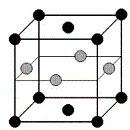Department of Physics and Astronomy: Publications and Other Research

Ralph Skomski Publications
Document Type
Article
Date of this Version
7-2013
Citation
IEEE TRANSACTIONS ON MAGNETICS, VOL. 49, NO. 7, JULY 2013; DOI: 10.1109/TMAG.2013.2245498
Abstract
The effects of substituting Zr by Hf on the structural and the magnetic properties of the nanocrystalline rapidly solidified Zr18-xHfxCo82 ribbons (x = 0, 2, 4, and 6) have been studied. X-ray diffraction and thermomagnetic measurement results indicated that upon rapid solidification processing four magnetic phases occur: rhombohedral Zr2Co11, orthorhombic Zr2Co11, hcp Co, and cubic Zr6Co23 phases. Microstructure analysis results showed the reduction in the percentage of the soft-magnetic phase (Co) compared to the hard-magnetic phase (Zr2Co11 (rhombohedral)) with the increase in the Hf concentration. All the samples under investigation have ferromagnetic nature, at 4.2 K and at room temperature. The coercive force (Hc) and the saturation magnetization (Ms) are found to linearly increases with x (x ≤ 2), then (Hc) slightly increases and Ms slightly decreases with increasing x. The maximum energy product (BH)max at room temperature is found to increases with increasing x reaching a maximum value for x= 4 . The magnetocrystalline anisotropy parameter of these samples are calculated to be K = 1.1 MJ/m3 and independent of Hf concentration. The above results indicate that the replacement of Zr by Hf improves the hard-magnetic properties of this class of rear-earth-free nanocrystalline permanent magnet materials.


Comments
Copyright 2013 IEEE. Used by permission.